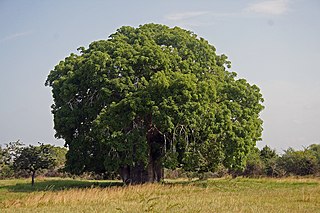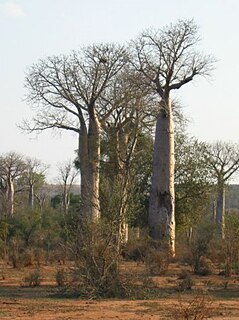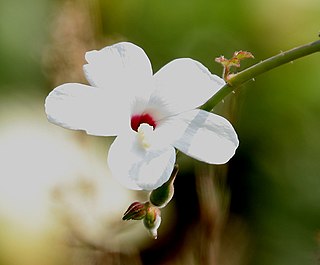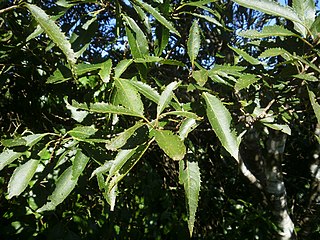
The Malvales are an order of flowering plants. As circumscribed by APG II-system, the order includes about 6000 species within 9 families. The order is placed in the eurosids II, which are part of the eudicots.

Adansonia is a genus made up of eight species of medium to large deciduous trees known as baobabs. Previously classified within the family Bombacaceae, they are now placed in the Malvaceae. They are native to Madagascar, mainland Africa and Australia. Trees have also been introduced to other regions such as Asia. The generic name honours Michel Adanson, the French naturalist and explorer who described Adansonia digitata. The baobab is also known as the "upside down tree", a name that originates from several myths. They are among the most long-lived of vascular plants and have large flowers that are reproductive for a maximum of 15 hours. The flowers open around dusk; opening so quickly that movement can be detected by the naked eye and are faded by the next morning. The fruits are large, oval to round and berry-like and hold kidney-shaped seeds in a dry, pulpy matrix.

Tilia americana is a species of tree in the family Malvaceae, native to eastern North America, from southeast Manitoba east to New Brunswick, southwest to northeast Oklahoma, southeast to South Carolina, and west along the Niobrara River to Cherry County, Nebraska. It is the sole representative of its genus in the Western Hemisphere, assuming T. caroliniana is treated as a subspecies or local ecotype of T. americana. Common names include American basswood and American linden.

Dracaena reflexa is a tree native to Mozambique, Madagascar, Mauritius, and other nearby islands of the Indian Ocean. It is widely grown as an ornamental plant and houseplant, valued for its richly coloured, evergreen leaves, and thick, irregular stems.

Pachira aquatica is a tropical wetland tree in the mallow family Malvaceae, native to Central and South America where it grows in swamps. It is known by its nonscientific names Malabar chestnut, French peanut, Guiana chestnut, Provision tree, Saba nut, Monguba (Brazil), Pumpo (Guatemala) and is commercially sold under the names Money tree and Money plant. This tree is sometimes sold with a braided trunk and is commonly grown as a houseplant, although more commonly what is sold as a "Pachira aquatica" houseplant is in fact a similar species, P. glabra.

Sparrmannia africana, the African hemp or African linden, is a species of flowering plant in the family Malvaceae, native to open woodland in Africa, South Africa and Madagascar. It is one of up to seven species in the genus Sparrmannia. The genus name is after Anders Sparrman.

Adansonia za is a species of baobab in the genus Adansonia of the family Malvaceae. It was originally named in French as anadzahé. Common names in Malagasy include bojy, boringy, bozy, bozybe, ringy, and za, the last of which gives the plant its specific epithet. Eight Adansonia species are recognized, with six endemic to Madagascar. Adansonia za is the most widespread of the Madagascar endemics.

The nelicourvi weaver is a species of bird in the family Ploceidae. It is endemic to Madagascar. Together with its closest relative, the sakalava weaver, it is sometimes placed in a separate genus Nelicurvius. A slender, sparrow-like bird, it is 15 cm (5.9 in) long and weighing 20–28 g (0.71–0.99 oz). Breeding males have a black bill and head, brown eyes, yellow collar, grey belly, chestnut-brown lower tail coverts, olive back, and blackish flight feathers edged greenish. Non-breeding males have mottled grey and green heads. In the breeding female the front of the head is yellow and the back olive green, with a broad yellow eyebrow. It builds solitary, roofed, retort-shaped nests, hanging by a rope from a branch, vine or bamboo stem, in an open space. It primarily feeds on insects, looking on its own or in very small groups, often together with long-billed bernieria. Its natural habitat is subtropical or tropical moist lowland and mountain forests. The conservation status of Nelicourvi weaver is least concern according to the IUCN Red List.

Abelmoschus ficulneus is a species of flowering plant in the genus Abelmoschus, family Malvaceae. Commonly known as white wild musk mallow or native rosella, it is fibrous perennial with a woody stem. Its flowers are about an inch in diameter, either pink or white, with a rose center; its leaves are palmate.

Hoheria sexstylosa, the long-leaved lacebark or ribbonwood, is a species of flowering plant in the family Malvaceae, endemic to New Zealand. It is an evergreen tree or shrub growing to 8 m (26 ft) tall by 6 m (20 ft) broad with glossy green leaves, and white flowers in summer and autumn. This tree tends to have a weeping graceful habit and is sometimes sold by nurseries with the name graceful lacebark. The Latin term sexstylosa means "six styles".

Hoheria angustifolia, the narrow-leaved lacebark or narrow-leaved houhere, is a species of flowering plant in the family Malvaceae, endemic to New Zealand. It is an evergreen tree or shrub with a weeping habit and grows to 10 m (33 ft) tall. Known as Houhere or Houhi in Māori, the bark of the tree was occasionally used for traditional textiles, similar to the traditional use of Hoheria populnea.

The flora of Madagascar consists of more than 12,000 species of plants, as well as a poorly known number of fungi and algae. Around 83% of Madagascar's vascular plants are found only on the island. These endemics include five plant families, 85% of the over 900 orchid species, around 200 species of palms, and such emblematic species as the traveller's tree, six species of baobab and the Madagascar periwinkle. The high degree of endemism is due to Madagascar's long isolation following its separation from the African and Indian landmasses in the Mesozoic, 150–160 and 84–91 million years ago, respectively. However, few plant lineages remain from the ancient Gondwanan flora; most extant plant groups immigrated via across-ocean dispersal well after continental break-up.
Rhopalocarpus mollis is a tree in the family Sphaerosepalaceae. It is endemic to Madagascar. The specific epithet mollis is from the Latin meaning "soft", referring to the very soft indumentum on the leaves' underside.
Xerochlamys coriacea is a tree in the family Sarcolaenaceae. It is endemic to Madagascar.

Xerochlamys elliptica is a tree in the family Sarcolaenaceae. It is endemic to Madagascar.
Perrierodendron quartzitorum is a plant in the family Sarcolaenaceae. It is endemic to Madagascar.

Megistostegium is a genus of trees and shrubs in the family Malvaceae. The species are all endemic to Madagascar. The genus is threatened by livestock grazing, invasive plants and threats to pollinators.
Megistostegium nodulosum is a tree in the family Malvaceae. It is endemic to Madagascar.
Megistostegium perrieri is a plant in the family Malvaceae. It is endemic to Madagascar.
Anthostema madagascariense is a species of flowering plant in the family Euphorbiaceae. It is a small to medium-sized tree or large bush, endemic to Madagascar, the Comoro Islands and Mayotte.














